Refrigerator instead of Bruce Willis: Earth hits first
Contrary to the scenario of the film "Armageddon", humanity does not wait until the last moment before the fall of the asteroid. On the contrary, the Earth is going to be the first to attack an innocent and harmless asteroid in order to practice deflecting potentially dangerous celestial bodies. The mission of NASA and the European Space Agency is in development, but it is already known that it will consist of several devices at once - except for the DART "warhead" itself, the Hera, which recently acquired its partners, the APEX and Juventas cusps, will fly.
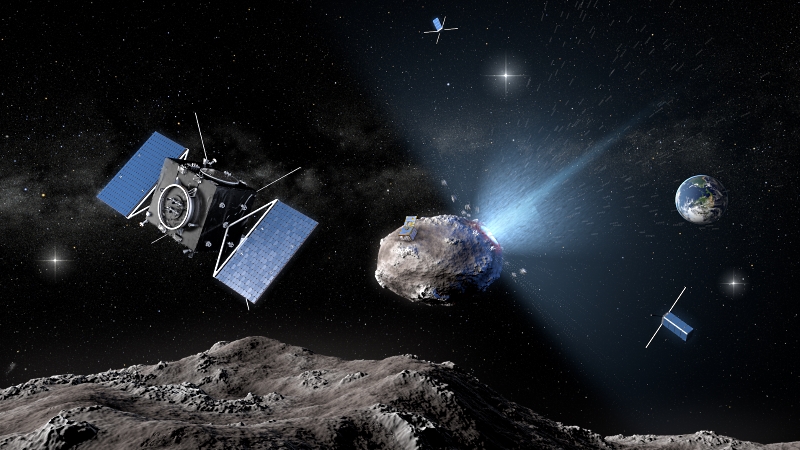
The moment of collision in the artist's representation, the image of the ESA
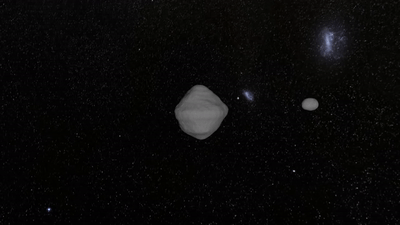
On the animation, another asteroid (185851) 2000 DP107, but Didim and his companion look like ESA video
A rather rare thing is moving between the Earth and the asteroid belt in orbit - a double asteroid system. It is formed by (65803) Didim with a diameter of 800 meters and a small 150-meter S / 2003 (65803) 1 with the unofficial name "Didymoon" ("Didiluna"). In the pericenter, asteroids approach the Sun up to 1.013 astronomical units, and in the apocenter they go farther than Mars, into the asteroid belt, up to 2.27 AU.
')
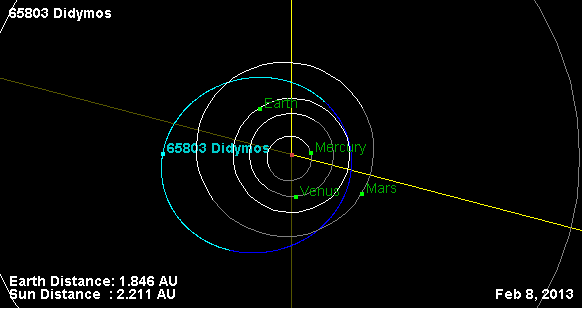
Image of Rinby / Wikimedia Commons
Asteroids are classified as potentially dangerous, but do not pose an immediate threat. In 2003, they flew past us about 19 times farther from the moon, and the next convergence is expected in 2123. During the rendezvous of 2003, the asteroids examined the radar and, by combining its data with the photometric (brightness in the optical range), got this image.

ESA image
In 2015, NASA and ESA decided to jointly conduct an experiment to change the asteroid's orbit. The project was called AIDA, but in 2016, the agencies' roads diverged, and the mission split into two - directly the NASA DART impactor and the ESA Hera research unit with its constituent cubsat.

DART, NASA image
The design of the device may still undergo changes, but since the DART is a kinetic warhead, there will be no complex scientific equipment on it. At the same time, the mission parallel to the main task will test new technologies in flight. The first is the NEXT-C xenon electrojet engine, which is an improved engine for the Dawn interplanetary station and will have to be commercially available. The second is the new rolled solar panels ROSA. This is not the first solar panels unfolding from a roll, but, for example, the option for the Hubble telescope was not particularly successful, and it was changed to hard ones. It also promises to improve and compactness and efficiency. ROSA panels successfully tested on the ISS in 2017.

In the collapsed state

And deployed. NASA Photos
The refrigerator from the name of the publication is related to the size of the device - it is 2.4 meters tall, and with the panels deployed, the width will grow to 12.5 meters.
The DART carrier rocket has not yet been defined. The launch window is open from December 2020 to May 2021, and it is assumed that it will fly with a commercial or military payload to the geostationary orbit. There, DART will turn on its engine and begin a long overclocking procedure to Didim.
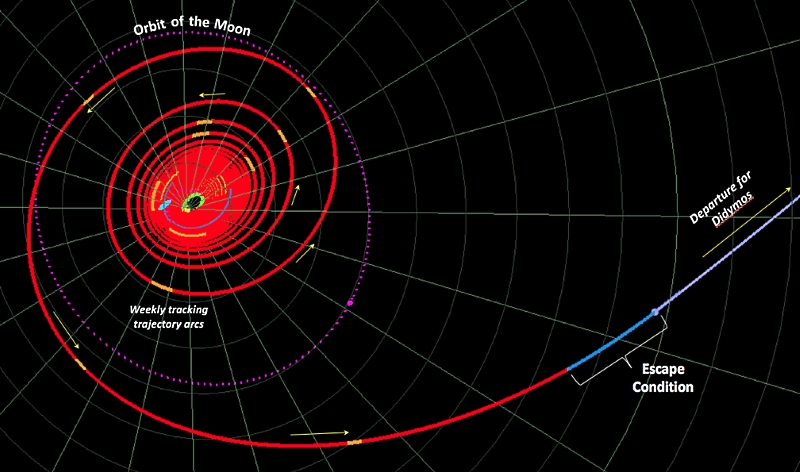
NASA scheme
The goal, Didilune, DART should approach on October 7, 2022. The speed relative to the asteroid at the time of the collision will be 6 km / s, and Didiluna’s orbit will change by 1%, enough for ground-based telescopes to fix. But companions from the European Space Agency at this moment near the orbit are not expected by today's plans, and this is the main sadness of the mission. The fact is that Hera should start in 2023, and it will reach the asteroid only in 2026. There is already a proposal to postpone the start of the DART, so that the rare and interesting event of the asteroid bombardment was recorded by direct witnesses.
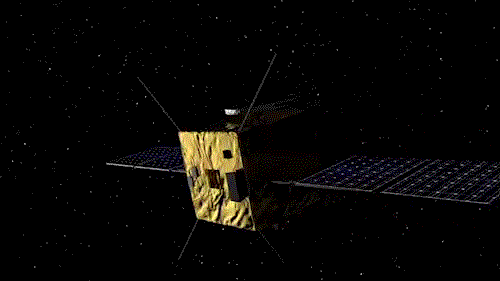
ESA Animation
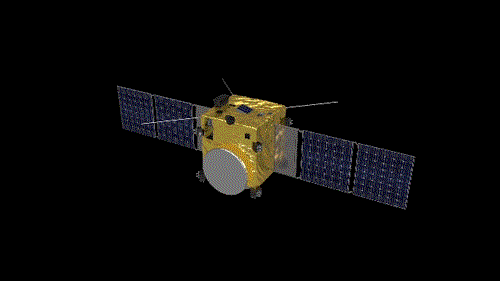
ESA Animation
The device Hera (Hera, the ancient Greek patroness of marriage) is made relatively simple with a fixed antenna of high amplification and solar panels. The standard fuel used is heptyl and amyl in four sixty-liter tanks and helium for pressurization. The station will weigh about 420 kg, of which the fuel will be 290 kg, and will have to go on a flight on an Ariane 6 launch vehicle that has not yet been completed.
Scientific instruments on the "Gera" will be four. In the visible range, the Visual Imaging System (VIS) will photograph the asteroid, and The thermal imager's (TIRI) operating in the infrared range will be able to determine the properties of the surface - whether it is bare rock, sand or dust. Also, TIRI will be able to show us the result of hitting it in this form:

Hypothetical view of the crater in the IR range, image of ESA
Also on the probe will be two radar - high and low frequencies. The high-frequency radar will be able to glance to a depth of 10 meters and determine the surface structure with a resolution of up to 0.2 m, while the low-frequency radar will be able to see through the asteroid through and find out its structure with a resolution of 30 m.
In addition to scientific instruments on the “Gera” there will be an engineering experiment - the radio channel will complement the Optel-D laser transmitter, which will allow testing the possibility of laser communication at interplanetary distances.
And finally, the design provides space for the MASCOT-2 landing gear (the first one landed the Hayabusa-2 probe on the asteroid Ryugu last fall) and two cubesates of the 6U form factor. In the fall of 2018, ESA began to choose the most interesting options and at the beginning of January announced what had been decided on with the finalists.

APEX, ESA image
The first was Asteroid Prospection Explorer, APEX ("Asteroid Exploration"). Its main scientific instruments will be the spectrometer for determining the surface composition and the magnetometer. They will perfectly complement the scientific instruments of “Gera” and together with them will allow collecting data on both the composition and the structure of the asteroid. The satellite will also have an optical navigation system, a lidar and engines, which will allow it not only to photograph the surface from a very close distance without risking the “Hero”, but also to land.

Juventas, ESA image
The second device is Juventas, which they plan to equip with a gravitometer and low-frequency radar. Together with the "Hero" he will be able to conduct experiments in the radio. Its existence should also end in a soft landing and work on the surface of one of the asteroids.
From the point of view of celestial mechanics, the idea of rejecting an asteroid with a controlled impact is absolutely reasonable - for Apollo group asteroids with a pericenter in the Earth, a slight acceleration from a collision with the earth apparatus at the apocenter (the point of orbit farthest from the Sun) will lead to the asteroid never will not get close to Earth at a dangerous distance. And with modern telescopes, we know well enough about potentially dangerous near-earth objects (more than 140 meters, crosses the Earth's orbit) and can predict their trajectories for decades to come. The celestial bodies of the size of the Chelyabinsk meteorite (approximately 20 meters), however, are much more difficult to detect in advance with today's means, but the danger from them is less.
It is also impossible not to rejoice at the fact that the Cubsates are becoming constant companions of large vehicles - they allow you to collect more scientific data at a new level, and they are easier to risk.

The moment of collision in the artist's representation, the image of the ESA
Rare target

On the animation, another asteroid (185851) 2000 DP107, but Didim and his companion look like ESA video
A rather rare thing is moving between the Earth and the asteroid belt in orbit - a double asteroid system. It is formed by (65803) Didim with a diameter of 800 meters and a small 150-meter S / 2003 (65803) 1 with the unofficial name "Didymoon" ("Didiluna"). In the pericenter, asteroids approach the Sun up to 1.013 astronomical units, and in the apocenter they go farther than Mars, into the asteroid belt, up to 2.27 AU.
')

Image of Rinby / Wikimedia Commons
Asteroids are classified as potentially dangerous, but do not pose an immediate threat. In 2003, they flew past us about 19 times farther from the moon, and the next convergence is expected in 2123. During the rendezvous of 2003, the asteroids examined the radar and, by combining its data with the photometric (brightness in the optical range), got this image.

ESA image
In 2015, NASA and ESA decided to jointly conduct an experiment to change the asteroid's orbit. The project was called AIDA, but in 2016, the agencies' roads diverged, and the mission split into two - directly the NASA DART impactor and the ESA Hera research unit with its constituent cubsat.
Dart

DART, NASA image
The design of the device may still undergo changes, but since the DART is a kinetic warhead, there will be no complex scientific equipment on it. At the same time, the mission parallel to the main task will test new technologies in flight. The first is the NEXT-C xenon electrojet engine, which is an improved engine for the Dawn interplanetary station and will have to be commercially available. The second is the new rolled solar panels ROSA. This is not the first solar panels unfolding from a roll, but, for example, the option for the Hubble telescope was not particularly successful, and it was changed to hard ones. It also promises to improve and compactness and efficiency. ROSA panels successfully tested on the ISS in 2017.

In the collapsed state

And deployed. NASA Photos
The refrigerator from the name of the publication is related to the size of the device - it is 2.4 meters tall, and with the panels deployed, the width will grow to 12.5 meters.
The DART carrier rocket has not yet been defined. The launch window is open from December 2020 to May 2021, and it is assumed that it will fly with a commercial or military payload to the geostationary orbit. There, DART will turn on its engine and begin a long overclocking procedure to Didim.

NASA scheme
The goal, Didilune, DART should approach on October 7, 2022. The speed relative to the asteroid at the time of the collision will be 6 km / s, and Didiluna’s orbit will change by 1%, enough for ground-based telescopes to fix. But companions from the European Space Agency at this moment near the orbit are not expected by today's plans, and this is the main sadness of the mission. The fact is that Hera should start in 2023, and it will reach the asteroid only in 2026. There is already a proposal to postpone the start of the DART, so that the rare and interesting event of the asteroid bombardment was recorded by direct witnesses.

ESA Animation
Hera and Company

ESA Animation
The device Hera (Hera, the ancient Greek patroness of marriage) is made relatively simple with a fixed antenna of high amplification and solar panels. The standard fuel used is heptyl and amyl in four sixty-liter tanks and helium for pressurization. The station will weigh about 420 kg, of which the fuel will be 290 kg, and will have to go on a flight on an Ariane 6 launch vehicle that has not yet been completed.
Scientific instruments on the "Gera" will be four. In the visible range, the Visual Imaging System (VIS) will photograph the asteroid, and The thermal imager's (TIRI) operating in the infrared range will be able to determine the properties of the surface - whether it is bare rock, sand or dust. Also, TIRI will be able to show us the result of hitting it in this form:

Hypothetical view of the crater in the IR range, image of ESA
Also on the probe will be two radar - high and low frequencies. The high-frequency radar will be able to glance to a depth of 10 meters and determine the surface structure with a resolution of up to 0.2 m, while the low-frequency radar will be able to see through the asteroid through and find out its structure with a resolution of 30 m.
In addition to scientific instruments on the “Gera” there will be an engineering experiment - the radio channel will complement the Optel-D laser transmitter, which will allow testing the possibility of laser communication at interplanetary distances.
And finally, the design provides space for the MASCOT-2 landing gear (the first one landed the Hayabusa-2 probe on the asteroid Ryugu last fall) and two cubesates of the 6U form factor. In the fall of 2018, ESA began to choose the most interesting options and at the beginning of January announced what had been decided on with the finalists.

APEX, ESA image
The first was Asteroid Prospection Explorer, APEX ("Asteroid Exploration"). Its main scientific instruments will be the spectrometer for determining the surface composition and the magnetometer. They will perfectly complement the scientific instruments of “Gera” and together with them will allow collecting data on both the composition and the structure of the asteroid. The satellite will also have an optical navigation system, a lidar and engines, which will allow it not only to photograph the surface from a very close distance without risking the “Hero”, but also to land.

Juventas, ESA image
The second device is Juventas, which they plan to equip with a gravitometer and low-frequency radar. Together with the "Hero" he will be able to conduct experiments in the radio. Its existence should also end in a soft landing and work on the surface of one of the asteroids.
Conclusion
From the point of view of celestial mechanics, the idea of rejecting an asteroid with a controlled impact is absolutely reasonable - for Apollo group asteroids with a pericenter in the Earth, a slight acceleration from a collision with the earth apparatus at the apocenter (the point of orbit farthest from the Sun) will lead to the asteroid never will not get close to Earth at a dangerous distance. And with modern telescopes, we know well enough about potentially dangerous near-earth objects (more than 140 meters, crosses the Earth's orbit) and can predict their trajectories for decades to come. The celestial bodies of the size of the Chelyabinsk meteorite (approximately 20 meters), however, are much more difficult to detect in advance with today's means, but the danger from them is less.
It is also impossible not to rejoice at the fact that the Cubsates are becoming constant companions of large vehicles - they allow you to collect more scientific data at a new level, and they are easier to risk.
Source: https://habr.com/ru/post/435928/
All Articles